I don’t generally watch videos. Did they change or clarify anything significant?
I can appreciate that. To be honest, I'm not sure. Some of these topics were brought up in the Frag Garage Corals interview so I'm not sure if I heard it first here or in that video. But I updated my original post to include some questions (quoted below) if you find the time to consider them. Hopefully I'm not misquoting Fauna Marin's words. I tried not to.
1. Claims such as pH goes up along with carbonic acid seems counter intuitive to me.
2. "The most important thing is how many alkalinity I need during the day." (27:36 time stamp) I was a little surprised by. I thought I'd heard corals grow at night too. But Idk for sure.
3. I did think it was interesting, the claim the bolus style dosing created halogens that protect the corals from the high light. I'm not sure I know what that means but would love to hear from someone smarter than me.
4. Is it just me or did the sodium carbonate solution beaker with the precipitation fully dissolve into the water when he stirred it a second time? (16:56 time stamp) He claims the particles were simply broken into smaller particle sizes. Again, I'm not educated enough to confirm or refute that claim but would love to hear from others.
(By others I certainly intend to target @Randy Holmes-Farley . Not to exclude others...)























